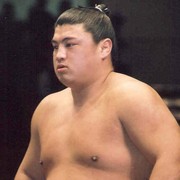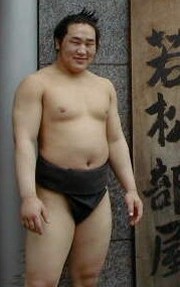| Brothers in Sumo – part one Brian Lewin |
 |
NHK & the Ozumo
English Broadcast
Mark Buckton
A visit to NHK, years of watching the show and the opinions of our Ed-in-Chief
Hanging With the Rikishi
Barbara Ann Klein
Barbara Ann Klein recounts her experiences with the “boys” in a pictorial diary series
| Rikishi of Old Joe Kuroda |
 |
Sumo Exhibit at the
Edo-Tokyo Museum
Barbara Ann Klein
SFM’s Editor takes in the exhibit celebrating 80 years of the Japan Sumo Association at this famous Tokyo museum
| Heya Peek John Gunning |
 |
| SFM Interview Dave Wiggins sits down |
 |
Photo Bonanza
What a collection – All-Japan Sumo Tournament, Hakkaku-
beya visit and sumo exhibits at the Edo-Tokyo Museum
Kyushu Basho Review
Lon Howard
Lon gives us his Kyushu Basho summary, along with the henka sightings results, and his take on the year in brief
Lower Division Rikishi
Mikko Mattila
Mikko Mattila covers lower division ups and downs
| Hatsu Basho Forecast Pierre Wohlleben & Mark Buckton |
 |
Sumo 101
Eric Blair
Eric explains all you need to know and then some about the Kokugikan building – the mecca of sumo
| Kimarite Focus Mikko Mattila |
 |
Minusha
John McTague
John’s unique bimonthly view of news from outside the dohyo
Online Gaming
Eric Blair
For the lowdown on Guess the Kotomitsuki – baby of SFM’s John Gunning
Kokugi Connections
Todd Lambert
Todd’s bimonthly focus on 3 of the most interesting sumo sites today
| Fan Debate Intra heya bouts – |
 |
SFM Cartoons
Stephen Thompson
In the second of our cartoon bonanzas, sit back and enjoy ST’s offerings
Let’s Hear From You
What was it that made you a sumo fan? American Todd Defoe tells all
Readers’ Letters
See what SFM readers had to say since our last issue
Sumo Quiz
The Quizmaster
Answer the Qs and win yourself next basho’s banzuke.

Yoshikaze as Onishi
Daishodai, and my dear friend Meike’s faves – Yoshikaze and Futeno.
And thenů there is my most successful adopted “son” – Dagvadorj Dolgorsuren.
I started following young Asashoryu after an asageiko-watching session at the old Wakamatsu-, now Takasago-, beya in 1999. The session was particularly intense, as most are in Takasago-beya, with much bullying and picking on one of the lower-ranked boys by the more senior, and in the case of Asashoryu, not-quite-yet senior, rikishi. While I was, at first, quite taken aback by this “cruel” treatment, I learned that this practice was pretty much S.O.P in some heya “to build stamina”. (Indeed, I subsequently witnessed this “stamina-building” in at least two other heya.) I also discovered later that rikishi on the cusp of promotion to the
Anyway, at the time of our visit (I was with two other list members), Asashoryu was not on the receiving end of the bullying and he had already put the lowest two divisions solidly behind him, so it was with a keen eye that we had watched this young rikishi’s moves at training. Vowing to root for him – and trying hard to figure out how to pronounce his name correctly – Meike and I attended the basho daily, and when we recognized Asashoryu, or thought we heard his name, we would welcome him by yelling his name in a somewhat

The young Asashoryu
During my following trips to Tokyo for the bashos, usually twice a year, I continued to attend asageiko as frequently as possible, particularly at Wakamatsu/Takasago to get more glimpses of Asashoryu and see how he was faring during practice. Sometimes he was there, many times not – sometimes he acknowledged us, sometimes not – and when he became komosubi, I (Meike, too) almost lost heart that we would never see him or speak to him again personally. However, we persisted, and one day – Asashoryu was sekiwake by this time – he started to speak to us during asageiko. Not only speaking, but instigating the rest of his heya mates to “almost” fall on us, dancing jive and doing other slapstick type performances – obviously for our benefit and enjoyment. Oh, how we tried to suppress our laughter in an effort to maintain our senses of the decorum required of asageiko attendees! Then, after keiko was over, he turned to a supporter who was also in attendance and told him that we were “old” friends. We were invited to chanko with him
Next Home
